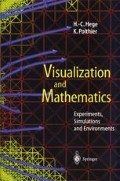Summary
We describe a framework for Visualization in Scientific Computing (ViSC). Our interest is in visualizing time dependent multidimensional data. Our proposal is to isolate the data reduction process from the graphical presentation process and to consider time as a continuous variable, treating it as a first class object. The framework is based on the following three models:
-
A scientific data model, derived from the theory of fiber bundles, encapsulating multidimensional data over time and implemented as a cluster of classes.
-
A graphical data model which is a set of time dependent objects encapsulating shape and shading. This model appears to the external world as a set of independent variables.
-
A linear inductive reductive dataflow model that supports the progressive reduction of scientific variables and the progressive computation of graphical variables.
Access this chapter
Tax calculation will be finalised at checkout
Purchases are for personal use only
Preview
Unable to display preview. Download preview PDF.
References
M. B. Johnson, WAVESworld, a testbed for constructing 3D semi-autonomous animated characters, PHD, Program in Media Arts and Sciences, MIT (1995).
J. Favre and J. Hahn, An Object Oriented Design for the Visualization of Multi-Variable Data Objects, IEEE Proceedings of Visualization’94 (1994).
W. Ribarsky, E. Ayers, J. Eble, and S. Mukherjea, Glyphmaker: Creating Customized Visualizations of Complex Data,IEEE Computer 27:7 (1994), 5764.
J. Lemordant, Visualization of Depth Maps, Computer Graphics and Mathematics, Eurographics, Springer Verlag (1992), 263–283.
D. Butler and M. Pendley, A visualization model based on the mathematics of fiber bundles, Computers in Physics (1989), 45–51.
R. Haber, B. Lucas, and N. Collins, A Data Model for Scientific Visualization with Provisions for Regular and Irregular Grids,IEEE Proceedings of Visualization’91 (1991), 298–305.
B. Lucas, G. Abram, N. Collins, D. Epstein, D. Gresh, and K. McAuliffe, An Architecture for a Scientific Visualization System,IEEE Proceedings of Visualization’92 (1992), 107–114.
M. Spivak, A Comprehensive Introduction to Differential Geometry,Publish or Perish (1979).
D. Dyer, A datafiow toolkit for visualisation, Computer Graphics and Applications 22:4 (1990), 60–69.
C. Upson, Visual Programming in Data Flow Environments, University Video Communications, The distinguished lecture series IV, Stanford (1992).
C. Upson, T. Faulhaber, Jr. D. Kamins, D. Laidlaw, D. Schlegel, J. Vroom, R. Gurwitz, and A. Van Dam, The application visualization system: a computational environment for scientific visualization, Computer Graphics and Applications 9 (1989), 30–42.
J. Rasure, D. Argiro, T. Sauer and C. Williams, A visual language and software development environment for image processing, International Journal of Imaging Systems and Technology (1991).
D. Ingalls, S. Wallace, Y. Chow, and L. K. Doyle, Fabrik: A visual Programming Environment, OOPSLA’88 Proceedings (1988), 176–190.
R. Duisberg, Animation Using Temporal Constraints: An Overview of the Animus System, Human-Computer Interaction (1988), 275–307.
F. Harbab and I. Herman, Manifold: A Language for Specification of Inter-Process Communication, Interactive Systems, Centre for Mathematics and Computer Science (1990).
P. Van Berkel, SIAS, Strokes Interpreted Animated Sequences, Computer Graphics Forum 8 (1989), 35–47.
N. W. John and P. J. Willis, The Controller Animation System, Computer Graphics Forum 8 (1989), 133–138.
V. Watson, G. Bancroft, B. Plessel, F. Merritt, and P. P. Wanlatka, Visualization of Supercomputer Simulations in Physics,Computing Machinery 8 (1989), 647–654.
Lorensen et. al., Visage: An Object-Oriented Scientific Visualization System, IEEE Proceedings of Visualization’92 (1992).
V. De Mey and S. Gibbs, A MultiMedia Component Kit: Experiences with Visual Composition of Applications, ACM Multimedia (1993), 291–300.
M. Tarlton and P. Tarlton, A Framework for Dynamic Visual Applications, ACM Multimedia (1993), 161–164.
K. Polthier and M. Rumpf, A Concept for Time-Dependent Processes,in: M. Göbel, H. Müller, and B. Urban (eds.), Visualization in Scientific Computing, Springer Verlag (1995), 137–153.
D. Tsichritzis, Visual Objects, Université de Genève (1993).
A. Van Dam et. al., An Object Oriented Framework for the Integration of Interactive Animation techniques, Computer Graphics (SIGGRAPH ’81 Proceedings) (1991), 105–111.
J. Lemordant, Object Oriented Visual Programming Systems,OOCNS’94, Heidelberg (1994).
P. Genoud, HOPI: An Object-Oriented Datafiow Visual Programming Environment, OOCNS’94, Heidelberg (1994).
L. Darlet, Computer Aided Scientific Visualisation,PhD, University Joseph Fourier Grenoble (1995).
Author information
Authors and Affiliations
Editor information
Editors and Affiliations
Rights and permissions
Copyright information
© 1997 Springer-Verlag Berlin Heidelberg
About this chapter
Cite this chapter
Lemordant, J. (1997). Linear Inductive Reductive Dataflow System for ViSC. In: Hege, HC., Polthier, K. (eds) Visualization and Mathematics. Springer, Berlin, Heidelberg. https://doi.org/10.1007/978-3-642-59195-2_18
Download citation
DOI: https://doi.org/10.1007/978-3-642-59195-2_18
Publisher Name: Springer, Berlin, Heidelberg
Print ISBN: 978-3-642-63891-6
Online ISBN: 978-3-642-59195-2
eBook Packages: Springer Book Archive

